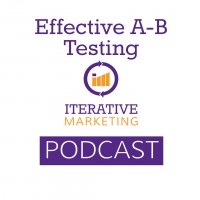
- Social:
- Link:
- Embed:
Show Notes
A-B testing is the core of experimentation. With the right execution, it not only provides uplift in click-through rate and conversions, but also serves as an audience insight generator. This podcast explores how six things — sample size, random sample, controls, duration, statistical confidence and testing for insight — can make an A-B test effective and beneficial to all departments in an organization.
What is an A-B Test (2:59 – 4:29)
- The testing of two different versions of the same content to determine which results in a better outcome
- A-B tests are important to Iterative Marketing because they are the core of experimentation
- Can apply to any medium (print, banner ads, direct mail, email, etc.)
- Tools for A-B testing (Optimizely, Convert, Google Optimize) are becoming more user-friendly. Many testing tools are embedded in platforms like Marketo and Pardot.
Why A-B Testing Is Important (4:30 – 6:06)
- Produces an impact on our marketing that is based on data, rather than gut feelings or personal preference for the best way to allocate marketing resources
- Helps multiple departments find out definitively what the audience prefers
Six Things That Make an A-B Test Work (6:07 – 7:06)
- Sample size
- Random sample
- Controls
- Duration
- Statistical confidence
- Testing for insight
1) Sample Size (7:07 – 9:42): The number of times you need to present version A or version B to determine a clear winner
- Sample size calculators can help you determine how big of an audience you need to achieve 90% or 95% confidence.
- Marketers should not attempt a test if you are not going to have a big enough sample. It’s important to determine this BEFORE you start the A-B test to not waste resources.
2) Random Sample (9:43 – 11:42): Sample must not only be large enough, but it must also be segmented randomly.
- Many tools do this for us
Charity Break – American Foundation for Suicide Prevention – (11:43 – 12:30)
3) Control (12:32 – 17:10): The efforts put in place to make sure the thing being tested is the only thing that’s different between the experience of those getting version A and those getting version B.
- Test only one variable at a time so you know which change is producing the result
- Design version A and version B as exact replicas in layout, font size, color etc. except for the variable being changed to isolate what is being tested
- Run the test with version A and version B at the same time so breaking news, weather, or other elements, do not change the outcome of the test
- Make sure your audience has not seen either version before the test starts
4) Duration (17:11 – 18:49): How long to run an A-B test
- In our experience, do not run a test longer than 90 days because too many factors may impact the result
- If testing relies on cookies in a browser, they are not reliable for more than a few weeks
- A test should be run long enough to factor in various business cycles
- Ex: Running a test Thurs-Mon favors weekend habits, while running it Mon-Thurs favors weekday habits.
5) Statistical Confidence (18:50 – 21:35): A complicated math equation to help us determine if an A-B test is repeatable, or the result of chance
- We have an easy-to-use A-B confidence calculator on our website. Simply plug in your impressions or sessions compared to clicks or conversions to find out the statistical significance
- Usually represented as a percentage, which represents probability.
- Ex: If results are 95%, it means if you ran the same test 100 times, you’d expect 95 of those to work out with the same winner.
- Resource: Podcast Episode 22: Let’s Talk Statistics
- Marketers usually strive for 95% confidence, although we have taken the results of a test with 90% confidence as usable information, or as a good working hypothesis until a better test can be run.
6) Testing for Insight (21:36 – 26:12): Learning more about our audience beyond gaining an increase in click-through rate or conversions.
- The best A-B tests test the psychographics of an audience segment to gain insight that can be applied to multiple departments in an organization.
- To get started, brainstorm a hypothesis for how you expect your audience to act and why. Then, build an A-B test to validate or invalidate that hypothesis.
- Ex: A bad hypothesis would be — “The headline, ‘Don’t make these three massive mistakes’ will result in more conversions than the headline, ‘Use these three tips to amp-up your results.’”
- This hypothesis is not audience-specific and is very specific to this piece of content.
- Ex: A good hypothesis would be — “Mary (our persona) will be more likely to convert when presented with an offer that limits her risk because Mary prefers avoiding risk over new opportunity.”
Summary (26:14-28:49)
We hope you want to join us on our journey. Find us on IterativeMarketing.net, the hub for the methodology and community. Email us at podcast@iterativemarketing.net, follow us on twitter at @iter8ive or join The Iterative Marketing Community LinkedIn group.
The Iterative Marketing Podcast is a production of Brilliant Metrics, a consultancy helping brands and agencies rid the world of marketing waste.
Producer: Heather Ohlman
Transcription: Emily Bechtel
Music: SeaStock Audio
Onward and upward!
Leave a Reply